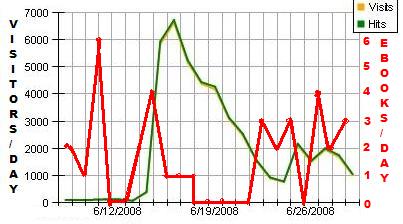The graph below shows sales for my latest ebook plotted against the number of visitors per day for an online excerpt from that book. The normal organic traffic for that page, primarily from search engines, has been steady at around a hundred visitors a day for the past six months. But a couple weeks ago, somebody tagged it as a page of interest on StumbleUpon, a sort of social networking or collaborative page ranking service. The problem with visitors from sites like this is that they are almost never looking for the particular book or information that is getting attention, it's more of a passing interest, a sort of internet windows shopping. My websites occasionally get these surges in visitors from casual visitors on a guided tour of some Internet segment, and the sell-through averages out to zero percent.

The page that normally draws a hundred visitors a day started drawing thousands of visitors a day from StumbleUpon alone. On some days, these visitors outstripped the total number of visitors from all other sources to all of the topics on my website. But sales of the ebook actually went down during this period, which can hardly be the fault of window shoppers, since there weren't enough of them to get in the way of the real buyers by crashing the site. What happened in fact is an excellent example of polluted data:-) At the same time that this traffic surge was occurring, the paperback version of the book was released, and on 6/16, I began promoting it on the website. I didn't remove the "buy" links for the ebook, I simply channeled most potential buyers through another page that included information about the paperback. Ebook sales crashed, and after a week I gave up and went back to sending everybody who expressed an interest in the ebook directly to the ebook ordering page. Sales jumped right back to the long term average of between two and three ebooks per day.
Selling visitors on the idea of buying an ebook for instant download anywhere in the world and then distracting them with a more expensive paperback that would take days or weeks to arrive is not a minor tweak to the ordering process. I was literally unselling some visitors who had made up their minds to purchase the ebook. The right visitors are a precious commodity for publishers, which is why it's important that somebody in your publishing company keeps an eye on the server statistics as well as the sell-through for order pages. And don't jump to conclusions based on raw data without understanding the context. If I was a manager running the fonerbooks website and didn't know about the paperback being released and promoted, I would have assumed that casual visitors were somehow depressing sales, rather than just the sell-through. Remember, sell-through depends on the total number of potential buyers, and by including a huge number of window shoppers in the total, the sell-through number is artificially brought low.
The only real measure of how well your website is performing its marketing function in selling your books is to keep an eye on the bottom line. This may be frustrating to webmasters or hired SEO guns who can "prove" to management that the website is humming on all cylinders, but if it's not selling books for the publisher, it's just another expense. I talked about this in a video last winter, which I'll embed here again for anybody who missed it.
3 comments:
I have had both my SmallPress Blog and my Best Online High Schools websites Stumbled upon. While it does temporary great goodness in terms of number of hits, I see no upswing in books sold, Google ads clicked, or anything else that actually puts money in my pocket.
Yes, it's nice to get all those hits. My preference, though, is cold, hard cash!
Tom,
Yes, it can be pretty stunning when a flood of visitors, orders of magnitude beyond the norm, dn't move the needle at all. But I suppose websites that carry pay-per-impression advertsing can make money that way, though it probably hurts their credibility in the long run.
Morris
I think you are exactly right. When it comes right down to it, the only thing you have in business is your reputation and your credibility.
Post a Comment